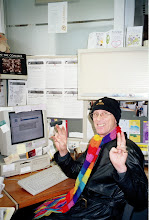SYDNEY'S iconic beaches, coastal houses, commercial property and roads will be threatened by rising sea levels by 2050, while the city's temperature is expected to rise by at least 2 degrees, a new scientific study, launched by the Premier, Nathan Rees, reveals.
"Today, the science is in for Sydney," Mr Rees said yesterday as he proclaimed the influence of the climate sceptic and former treasurer Michael Costa at an end in NSW.
"The Costa era of ambiguity around this issue is over. Along with the rest of the NSW public, I recognise that climate change is a reality and that the NSW Government needs to prepare for it," the Premier said. "There is no longer a climate-change sceptic at the centre of government decision-making in this state".
The study commissioned by the NSW Department of Climate Change, and adopted by the Government, was carried out by the University of NSW and uses research from the United Nations' peak scientific body, the Intergovernmental Panel on Climate Change.
It examines the effect of climate change on the greater Sydney metropolitan region from the Central Coast to Wollongong, along with other regions in rural NSW. The full state study is expected to be released in January.
"We've used world's best science to understand what will happen in different parts of this state so we can start planning now for the future," Mr Rees said. "We will all have to change the way we live to some degree."
The study finds that bushfires are likely to be more intense while rainfall may become more erratic, creating water shortages. But while winter rains decline, intense summer rain in parts of Sydney could increase flash flooding.
This, combined with higher temperatures, is expected to put the state's emergency services and health services under stress.
The study has enormous implications for urban planning, building standards and flood-risk mapping as well as agriculture. It finds by 2050 the expected sea level rise is likely to be 40 centimetres, reaching 90 centimetres by 2100. While the figure sounds deceptively small, a one-centimetre sea-level rise can cause erosion effects of up to one metre.
The projections would mean changes to the Sydney coastline, including the harbour, Parramatta River and the Georges River, said Professor Andy Short of the University of Sydney's coastal studies unit.
"Beaches with a low gradient like Narrabeen, Dee Why and Curl Curl are going to be the most heavily affected," he said.
This sea-level rise would also affect river estuaries and bays. As seawater invades estuaries, fish populations are likely to decline and water birds disappear.
A senior scientist with the Department of Climate Change, Peter Smith, told the forum, "Where you've got a hard promenade at beaches like Manly, you can expect a reduction in beach shape and the actual width of the beach. In some cases, beaches will possibly disappear."
The temperature rises, coupled with more erratic rainfall, are expected to hit southern NSW hardest, said Gary Allan, the project leader for climate risk management in the NSW Department of Primary Industries in NSW.
"In the Riverina, we have to consider the possibility of fairly significant change to agricultural practices as we have known them," he said.
Mr Rees said he would strongly support the federal Carbon Pollution Reduction Scheme and bring forward spending on energy efficiency measures to cut greenhouse gas emissions that cause climate change.
He said a proposed $63 million energy efficiency program to help low-income households cut their emissions would start next month in Orange and Bathurst, and move to Sydney early next year.
The plan, which had been flagged by the previous climate minister, Verity Firth, will affect up to 200,000 people including pensioners, public-housing tenants and Aborigines.
Indonesia tells bombers families get ready
17 years ago


No comments:
Post a Comment